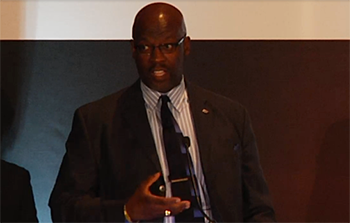Aerospace Businesses Must Be Flexible, Adaptable, Innovative Written 27 July 2016
Panelists: Co-Moderator Bonnie Prado Pino, doctoral student, School of Aeronautics and Astronautics, Purdue University; co-moderator Guillermo Jaramillo Pizarro, doctoral student, School of Aeronautics and Astronautics, Purdue University; Dave Bowles, director, NASA’s Langley Research Center; Duane Cuttrell, director of operations engineering and technical operations, Lockheed Martin Aeronautics; Julie Van Kleeck, vice president of space programs, Aerojet Rocketdyne; Rickey Shyne, director of research and engineering, NASA’s Glenn Research Center; John Steinmeyer, business development director, Orbital ATK
By Lawrence Garrett, AIAA Web Editor

Surviving in today’s dynamic aerospace environment, as well as succeeding and experiencing some amount of longevity, requires flexibility and an adaptability to the invariably changing times, as well as constant innovation, according to a panel of industry experts July 26 during the “Formula for Success and Longevity in the Aerospace Business” session at 2016 AIAA Propulsion and Energy Forum in Salt Lake City.
Julie Van Kleeck, vice president of space programs at Aerojet Rocketdyne, said there are four key factors that helped make Aerojet — a company that has existed for more than 70 years — so successful and longstanding: innovation, diversifying, listening to customers and being bold.
“You either innovate or stagnate,” she said, adding that the lesson is not only applicable to the aerospace industry. “Had we not continued to push the state-of-the-art, continued to bring new products to the marketplace, we wouldn’t be here today.”
Duane Cuttrell, director of operations engineering and technical operations at Lockheed Martin Aeronautics, said Lockheed is currently focused on segregating part of its business to focus more on the sustainment of its products.
Kleeck said businesses must diversify their portfolios, citing Aerojet’s broad base of customers in the defense, civil and commercial sectors. She also noted that diversifying helps maintain the stability of companies.
“When one business is up, another one might be down,” she said. “And so, we found that diversification of your business portfolio has been one of our keys to actually staying in the business.”
Cuttrell agreed.
“As we have one business that’s slow, we need to supplement that with workers or with skills from another one of our business areas,” Cuttrell said. “To date, we haven’t done that well.”
Rickey Shyne, director of research and engineering at NASA’s Glenn Research Center, said that in 1941, the center began looking only at propulsion systems for aircraft, but through the years, it evolved to end up working on space propulsion systems, chemical propulsion systems, electric propulsion systems and power systems for space and aeronautics.
“The key in all of that is looking at the core of what we do — make sure we do it well — and being flexible and agile, and applying those technologies and those core discipline areas for success to meet new mission requirements,” he said.
“One of the keys to innovation and longevity is being forward-looking enough to be able to see things before you actually need them — and I believe that’s what NASA has always been about,” Shyne said. “We do things that others dare to dream. We actually go do them.”
It’s also key to have diversity in personnel, Aerojet’s Kleeck said, adding that Aerojet cross-trains many of its employees so that they work across different types of propulsion.
Dave E. Bowels, director of NASA’s Langley Research Center, said that engineers at Langley touch upon everything the agency does, from aeronautics to science to technology to human space exploration.
“That, actually, I think, is one of our keys that I tell people when I’m out recruiting,” he said, explaining that he tells people they have an opportunity to diversify. “I think that’s been one of the keys to our success.”
Bowels also added that he believes it’s important to create an environment for people to be successful.
“I find if you just generate an environment for people to be successful, don’t micromanage them and then get out of their way, you’ll get some amazing things,” he said.
Lockheed’s Cuttrell said that the key to the success of any business starts with the individuals involved.
“Your competition has got to start with knowing yourself,” he said. “What do you bring to the table? What are your skills? How can you enhance those skills? How can you communicate those skills? And then further, what is the network that you can build moving forward such that others understand those skills?”
Listening to customers is also key, Kleeck said.
“We may not agree with our customers [all the time], but it really needs to be a two-way street,” she said.
Companies must also be “judiciously bold” to be successful in the long run, Kleeck said, adding, “If we make a big investment, it better pay off.”
John Steinmeyer, business development director at Orbital ATK, said Orbital was initially founded in 1982 by three friends attending Harvard Business School who dared to be bold. By 1990, Orbital successfully carried out eight space missions, highlighted by the initial launch of the Pegasus Launch Vehicle, what Steinmeyer called “the world’s first privately developed space launch vehicle.”
Echoing the other panelists, he agreed that innovation and technology development are important to attracting and motivating talent as well as to corporate longevity.
“However, I would say first and foremost is execution — continued execution on programs and commitments,” Steinmeyer said. “You really have to execute successfully before you can innovate successfully.”
